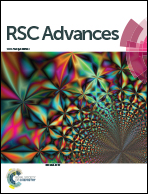A core–shell structured polyacrylonitrile@poly(vinylidene fluoride-hexafluoro propylene) microfiber complex membrane as a separator by co-axial electrospinning†
Abstract
A novel and facile core–shell structured polyacrylonitrile@poly (vinylidene fluoride-hexafluoro propylene) (PAN@PVDF-HFP) microfiber complex membrane was designed and fabricated via co-axial electrospinning, which was used as a separator in lithium-ion batteries. Poly(vinylidene fluoride-co-hexafluoro propene) (PVDF-HFP) and polyacrylonitrile (PAN) were used as the shell (outer) layer and core (inner), respectively. Structure, surface morphology, porosity, and thermal properties of the core–shell structured microfiber membranes were investigated. Compared with the traditional commercial porous polyethylene (PE) separator, the PAN@PVDF-HFP microfiber complex membranes exhibited higher porosity, superior thermal stability, better electrolyte wettability and higher ionic conductivity. As a consequence, batteries assembled with the PAN@PVDF-HFP microfiber complex membrane display better cycling stability and superior rate performance compared to those with the PE separator.



 Please wait while we load your content...
Please wait while we load your content...